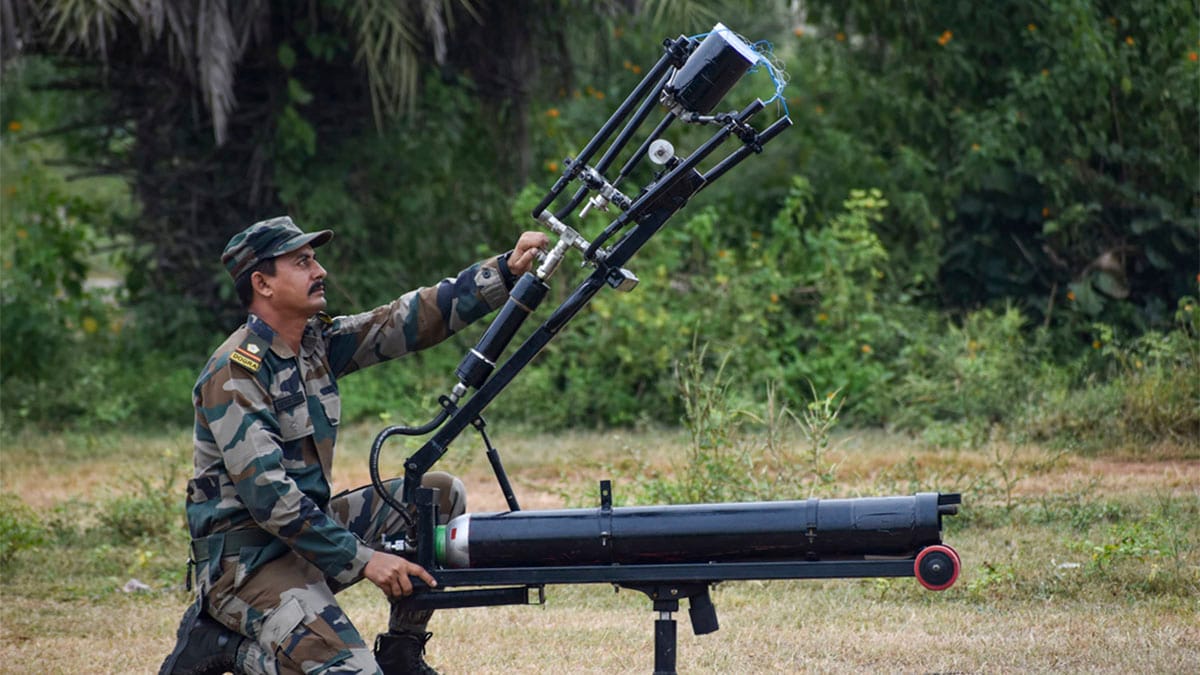Politics
India Tests Advanced Laser Weapon, Enhancing Defence Capabilities

India has marked a significant advancement in military technology with the successful testing of the Mk-II (A) Laser-Directed Energy Weapon (DEW) at the National Open Air Range in Kurnool. Conducted in April, this trial showcased the system’s capabilities to neutralise aerial threats, including drones and unmanned aerial vehicles (UAVs), positioning India among a select group of nations with such advanced technology. The Defence Research and Development Organisation (DRDO) reported that the 30 kW laser weapon demonstrated its effectiveness by disabling surveillance sensors and causing structural damage to various drones.
Directed Energy Weapons represent a new class of weaponry that employs concentrated energy rather than traditional projectiles to incapacitate or destroy targets. This energy can manifest as lasers, microwaves, or particle beams. DEWs are known for their advantages, including high speed, precision, and potentially lower costs per engagement compared to conventional weapons. Nevertheless, challenges remain, particularly concerning their effectiveness under varying atmospheric conditions and the long-term health impacts on personnel.
Understanding Directed Energy Weapons
DEWs function by emitting highly focused electromagnetic energy, directing it at a target to inflict damage through heating, melting, or disrupting electronic systems. The type of energy and its wavelength are crucial in determining how effectively these weapons can penetrate different materials. High-Energy Lasers (HELs) can deliver power outputs as low as 1 kW, with the precision to target and melt various substances.
High-Power Microwaves (HPM) produce longer wavelengths and can generate around 100 megawatts of power, capable of affecting multiple targets simultaneously. Millimetre Wave Weapons (MWW) operate in the 1 to 10-millimetre wavelength range, allowing them to disrupt or destroy electronic systems within a broader beam area. While Particle Beam Weapons (PBWs) are still in development, they could potentially engage targets at significantly longer ranges.
One of the most appealing aspects of DEWs is their operational speed, allowing engagement of targets at the speed of light. This capability minimizes collateral damage and offers a range of responses, from nonlethal options like temporarily disabling electronic systems to lethal actions that focus energy on critical components to incapacitate or destroy targets.
Challenges in Deployment and Future Prospects
Despite their advantages, several challenges hinder the operational deployment of DEWs. Environmental factors such as fog, rain, and dust can diminish laser effectiveness. Additionally, adversaries may develop countermeasures to deflect or disrupt DEWs, and the potential for unintended collateral damage raises concerns.
As DEWs transition from research and development to practical deployment, their applications in military contexts are becoming clearer. They are particularly well-suited for countering slower-moving threats like drones and artillery, with significant potential for missile defence against cruise missiles. According to the US Department of Defence, DEWs could serve as a cost-effective means of neutralising less sophisticated aerial threats, thus preserving more expensive interceptors for faster, more complex threats.
Globally, nations such as the United States, China, Russia, and Israel are investing heavily in DEW technology. The Iron Beam system developed by Israel, for instance, is designed to integrate into existing missile defence strategies, further illustrating the global interest in these advanced technologies.
India’s DRDO is actively pursuing advancements in DEWs, with a notable focus on the Mk-II (A) system, which is expected to be operational by 2027. This vehicle-mounted laser system aims to engage targets at distances up to 3.5 kilometres, enhancing India’s air defence capabilities significantly.
In conclusion, mastering DEW technologies represents a critical step in the evolution of defence systems worldwide. The increasing reliance on unmanned aerial systems and drone swarms has intensified the demand for effective countermeasures. As research continues and nations expand their capabilities, the future of directed energy weapons looks promising, with significant implications for military strategy and operational effectiveness.
-

 World5 months ago
World5 months agoSBI Announces QIP Floor Price at ₹811.05 Per Share
-

 Lifestyle5 months ago
Lifestyle5 months agoCept Unveils ₹3.1 Crore Urban Mobility Plan for Sustainable Growth
-

 Science5 months ago
Science5 months agoNew Blood Group Discovered in South Indian Woman at Rotary Centre
-

 World5 months ago
World5 months agoTorrential Rains Cause Flash Flooding in New York and New Jersey
-

 Top Stories5 months ago
Top Stories5 months agoKonkani Cultural Organisation to Host Pearl Jubilee in Abu Dhabi
-

 Sports5 months ago
Sports5 months agoBroad Advocates for Bowling Change Ahead of Final Test Against India
-

 Science5 months ago
Science5 months agoNothing Headphone 1 Review: A Bold Contender in Audio Design
-

 Top Stories5 months ago
Top Stories5 months agoAir India Crash Investigation Highlights Boeing Fuel Switch Concerns
-

 Business5 months ago
Business5 months agoIndian Stock Market Rebounds: Sensex and Nifty Rise After Four-Day Decline
-

 Sports5 months ago
Sports5 months agoCristian Totti Retires at 19: Pressure of Fame Takes Toll
-

 Politics5 months ago
Politics5 months agoAbandoned Doberman Finds New Home After Journey to Prague
-

 Top Stories5 months ago
Top Stories5 months agoPatna Bank Manager Abhishek Varun Found Dead in Well









